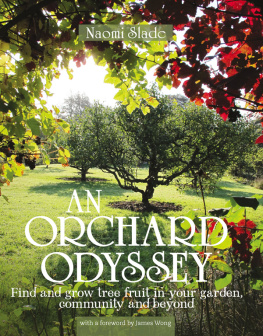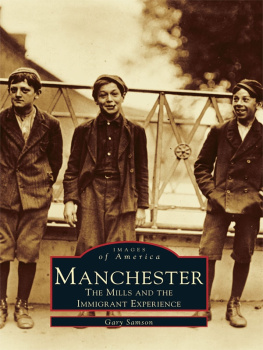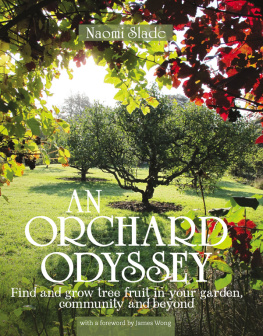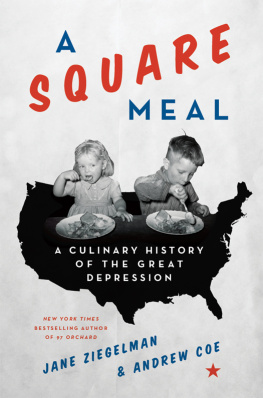Orchard tells the story of five immigrant families, each of them, as it happens, residents of a single New York tenement in the years between 1863 and 1935. Though separated by time and national background, the Glockners, the Moores, the Gumpertzes, the Rogarshevskys, and the Baldizzis, were all players in the Age of Migration, a period of sweeping demographic change for both the Old and New Worlds.
Starting in Europe in the early 1800s, whole chunks of humanity streamed from the countryside to the citiesthe continents new manufacturing centersin pursuit of work. Those who could afford to embarked on a trans-Atlantic migration, lured to the United States by the promise of American prosperity and freedom. 97 Orchard chronicles what became of those immigrants, but from a special vantage point: it retells the immigrant story from the elemental perspective of the foods they ate.
Within hours of landing, immigrants felt the keen pressures of assimilation. Before they even left Ellis Island, many had already traded in their Old World identities for new American names. Once on the mainland, immigrants found it expedient to shed their native clothing and to dress like Americans. Men quickly adopted the ubiquitous derby. Women abandoned their shawls and kerchiefs in favor of American-style coats and bonnets. The immigrants learned to speak like Americans, subjected themselves to the rigors of American sweatshops, and delighted in the popular culture of their adopted home. These same immigrants, however, went to extraordinary lengths to preserve their traditional foods and food customs. Transplanting Old World food traditionsmany of them rooted in the countrysideto the heart of urban America required both imagination and tenacity. To compound the challenge, the immigrants eating habits oftentimes defied American culinary norms, and as the immigrant population continued to swell, concerned citizens attempted to wean the foreigners from their strange cuisine. The immigrants food loyalties, however, were fierce. Native foods provided them with the comfort of the familiar in an alien environment, a form of emotional ballast for the uprooted. Within the immigrant community, food cemented relationships, and immigrants turned to food as a source of ethnic or national pride. As immigrant families put down roots, it also became a source of contention between parents and their American-born children for whom Old World foods carried the stigma of foreignness.
A large part of this story takes place in the immigrant kitchen. For many immigrants, this was a small, often windowless room in a five-or six-story brick tenement. A form of urban housing that began to appear on New Yorks Lower East Side in the 1840s, tenements were the first American residences built expressly for multiple familiesin this case, working people. The typical tenement had an iron front stoop, a central stairwell, where children played and neighbors socialized, and four apartments on every floor. The tenement kitchen was furnished with a wood-or coal-burning stove and little else. Those at 97 Orchard, a well-equipped building for its time, were bereft of indoor plumbing or any means of cold storage aside from the windowsill or fire escape, a makeshift ice box that only functioned in winter. A place to cook and to eat, the kitchen was also used as a family workspace, a sweatshop, a laundry room, a place to wash ones body, a nursery for the babies, and a bedroom for boarders. In this cramped and primitive setting, immigrant cooks brought their formidable ingenuity to the daily challenge of feeding their families. 97 Orchard describes exactly how that challenge was met by five major immigrant groups: the Germans, Irish, German Jews, Russian-Lithuanian Jews, and Italians.

East Side children were responsible for collecting wood and coal for the family stove.
To procure the ingredients they needed at prices they could afford, immigrant cooks depended on neighborhood food purveyors. Upon landing in America, immigrant entrepreneurs quickly established networks of food laborers, trades people, importers, peddlers, merchants, and restaurant-keepers. Many of these culinary workers have since vanished and are long-forgotten. Among the disappeared are the German krauthobbler s, or cabbage-shavers, itinerant tradesmen who went door to door slicing cabbage for homemade sauerkraut; the Italian dandelion pickers, women who scoured New Yorks vacant lots for wild salad greens; and the urban goose-farmers, Eastern European Jews who raised poultry in tenement yards, basements, and hallways.
The networks they established met the foreigners own culinary needs, but in the process of feeding themselves, they revolutionized how the rest of America ate.
A time traveler to preCivil War New York or Boston or Philadelphia, who happened to arrive at dinner time, could expect to encounter the following on the family table: roast beef stuffed with bread crumbs and suet, a dish of peas, and some form of pudding. This was sustenance for the professional or business class. Further down the economic ladder, generations of working-class Americans survived on hash, a composite of leftover meat scraps and potatoes. One food that united the haves and have-nots was pie. Apple pie, cherry pie, berry pie, lemon pie, and mince pie were eaten for breakfast, lunch, dinner, and dessert. The habit was so pronounced that immigrants referred to their American hosts as pie-eaters. Another universal food was oysters. While Americans devised a wealth of oyster-based recipes, including oyster patties and stews, they enjoyed them best in their natural state, sold raw from the saloons and street stands that proliferated in nineteenth-century cities.
The immigrants that began to settle in the United States in the 1840s introduced Americans to an array of curious edibles beyond their familiar staples: German wursts and pretzels, doughnut-shaped rolls from Eastern Europe known as beygals, potato pastries referred to as knishes, and the elongated Italian noodles for which Americans had no name but came to know as spaghetti. 97 Orchard describes how native-born Americans, wary of foreigners and their strange eating habits, pushed aside their culinary (and other) prejudices to sample these novel foods and eventually to claim them as their own.
Aside from satisfying our culinary curiosity, the exploration of food traditions brings us eye to eye with the immigrants themselves. It grants us access to the cavernous beer gardens that once lined the Bowery, where entire German familiesbabies includedspent their Sundays, the immigrants only day of leisure, over mugs of lager beer and plates of black bread with herring. It is a door into the East Side cafs where Jewish pushcart peddlers drank endless cups of hot tea with lemon, accompanied by a plate of blintzes, and brings us face-to-face with the Italian laborers who formed their own all-male cooking communities to satisfy their longing for macaroni.
On the streets of the Lower East Side, European food customs collided with the driving energy of the American marketplace. The tantalizing saga that ensued, an ongoing tug of war between culinary tradition and American opportunity, goes to the heart of our collective identity as a country of immigrants. But while 97 Orchard is concerned largely with a single immigrant community, Manhattans Lower East Side, the history it tells transcends that one urban neighborhood. Though on a smaller scale, comparable changes were underway in cities and towns across America wherever immigrants settled. In fact, though the actors have changed, the culinary revolution that began in the nineteenth century continues today among immigrants from Asia, Africa, the Caribbean, and Latin America, who have brought their food traditions to this country and continue to transform the way America eats.











